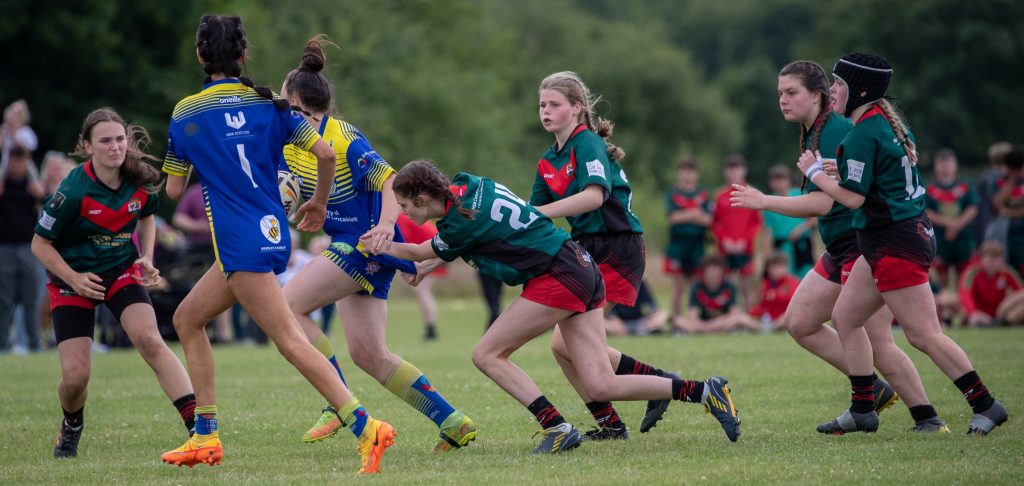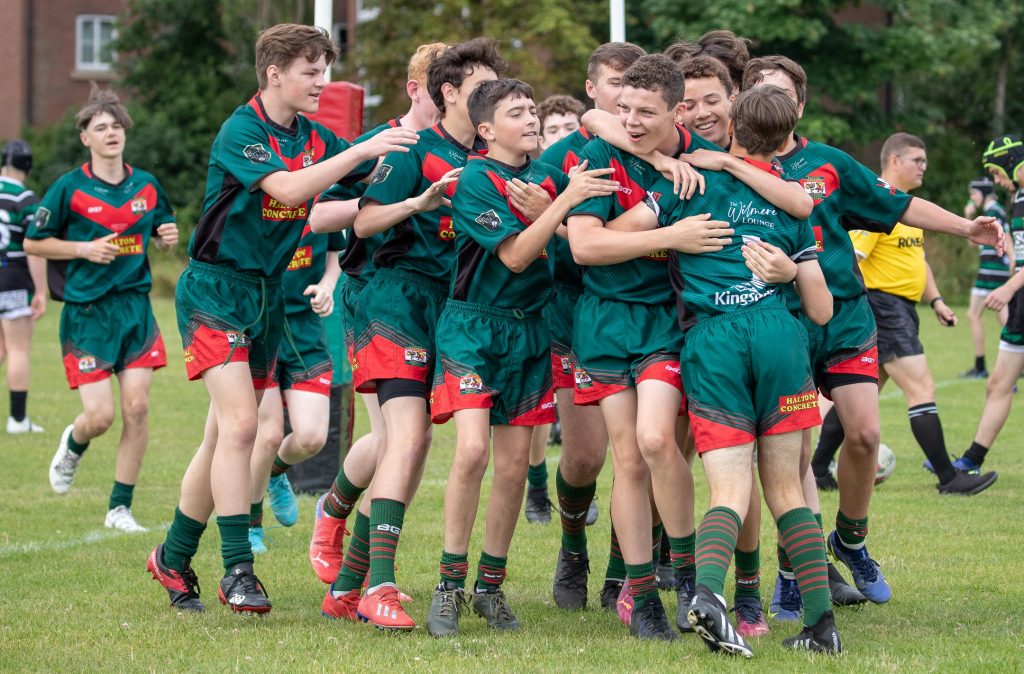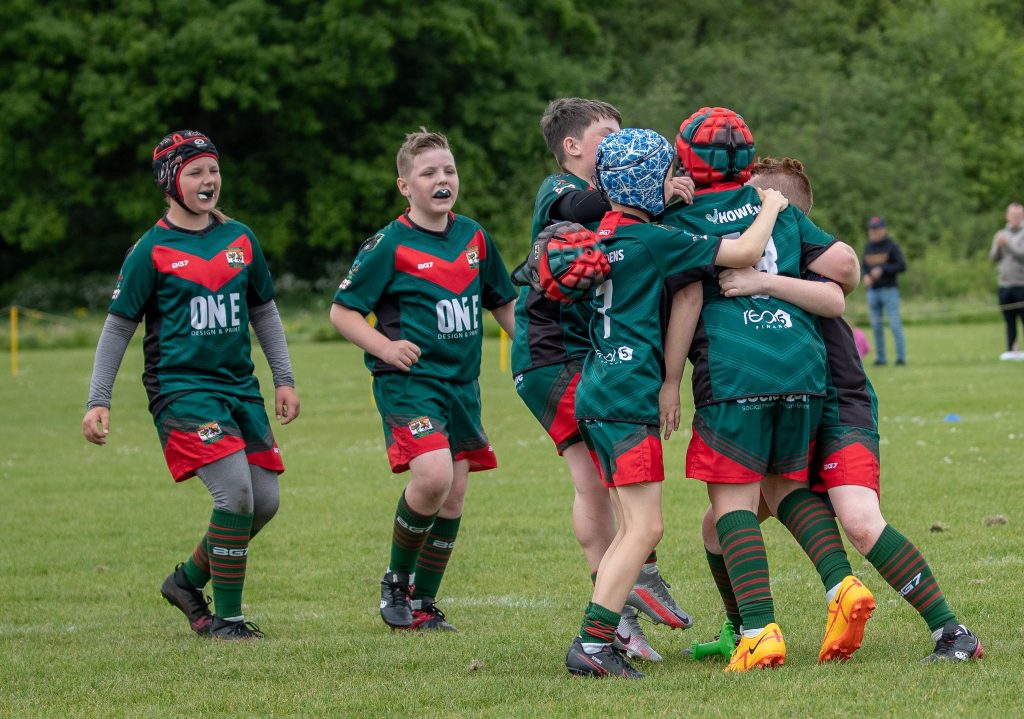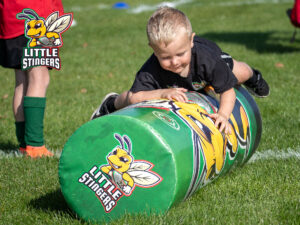
Little Stingers Graduation 2024
Little Stingers 2024 What a great year of Little stingers 🖤💚❤️🐝🏉 As always the kids have been amazing and I know we all feel blessed
Each Rugby League team has 13 players & 4 substitutes available at any time in the game. Each team is made up of 7 ‘backs’ and 6 ‘forwards’. The backs are generally regarded as the attacking players and usually have more pace than the bigger more powerful forwards who are usually the ‘yard’ makers.
For one team to score more points than the other team. A team can score points through scoring a ‘try’ or kicking a ‘goal’. Each team in effect, is given six tackles or chances to score. If after six tackles they have not achieved this then the ball is given to the other team who then also have the chance to score with six tackles. If a team has not scored by the fifth/last tackle then the ‘acting half-back’ will generally pass the ball to the teams ‘kicker’ who will punt the ball downfield in order to gain ‘territorial advantage’. The only disadvantage to this tactic is that if the ball goes out of play on the ‘full’ before bouncing, the opposition gain possession of the ball form where the kick was originally made. It becomes slightly more complicated than this, but if you grasp this concept then you will have a greater understanding of the game.
Click on a position to see their role
A full-back is often the most complete player on the team. The full-back is usually the last line of defence and often the first player making the break in attack. They need the safest hands in the team.
They are responsible for catching the opposition’s high and testing kicks in attack. A full-back can suddenly turn defence into attack, make important last-ditch tackles and make the extra man in attack.
Speed is what the winger is all about – and you need plenty of it. But to be a truly dependable winger, you need to pick up those difficult passes in tight spaces.
So as well as the speed of a sprinter, you need hands like glue – the ball needs to stick to you every time you get it.
But don’t think you’re only responsibility is in attack. Often the winger can be the last line of defence, so you need to be able to make those important tackles when they count.
The centre is always in the thick of things, whether in attack or defence. They should be comfortable creating space for wingers as well as making that last-ditch tackle. Centres can expect to do plenty of running up and down the pitch.
The centre is always in the thick of things, whether in attack or defence. They should be comfortable creating space for wingers as well as making that last-ditch tackle. Centres can expect to do plenty of running up and down the pitch.
Speed is what the winger is all about – and you need plenty of it. But to be a truly dependable winger, you need to pick up those difficult passes in tight spaces.
So as well as the speed of a sprinter, you need hands like glue – the ball needs to stick to you every time you get it.
But don’t think you’re only responsibility is in attack. Often the winger can be the last line of defence, so you need to be able to make those important tackles when they count.
The stand-off is the brains of the team – the player who makes the important decisions in attacks. A brilliant stand-off has the kicking skills of an international footballer. Whether it be a place kick, a drop kick or just a plain old punt, the stand-off needs to make every kick count.
They also need to be as good a passer as their half-back partner, the scrum-half. They also have to make the big tackles under pressure when it counts.
The scrum-half is the link between the forwards and the backs. They can expect to make plenty of passes to team-mates.
Scrum-halfs need to have the safest pair of hands on the team – as well as a brilliant rugby league brain. They are the player who makes the important passes, and need to make the right pass at the right time. The scrum-half is the player who feeds the ball into the scrum.
Front row forwards must enjoy bashing their way through tackles and making big tackles when they count.
They are also the first line in the scrum, so can expect plenty of tussles and battles with their opposite number. As always, they need excellent ball handling skills and a good rugby league brain.
The hooker probably makes more contact with the ball than any other player on the field. They often are the players who act as the dummy half after a play the ball, swinging the passes out or breaking down the opposition’s defence.
As the centre of the scrum, the hooker is the player whose job it is to win the ball from the scrum-half’s feed. Then, on top of that, they are expected to make plenty of tackles when they matter.
Front row forwards must enjoy bashing their way through tackles and making big tackles when they count.
They are also the first line in the scrum, so can expect plenty of tussles and battles with their opposite number. As always, they need excellent ball handling skills and a good rugby league brain.
Like the prop forwards, the second rows get stuck in at the deep end. Making tackles and breaking down the opposition’s defence are two things every second rower loves doing.
On top of that, they are also an important part of the scrum, providing the power behind the front row. As always, a good pair of hands and a good engine are required to be a quality second row.
Like the prop forwards, the second rows get stuck in at the deep end. Making tackles and breaking down the opposition’s defence are two things every second rower loves doing.
On top of that, they are also an important part of the scrum, providing the power behind the front row. As always, a good pair of hands and a good engine are required to be a quality second row.
The loose forward will always be found in the thick of the action. It is a job that requires plenty of running, so they need to be super fit.
Not only that, loose forwards have to have excellent handling skills and a defence as tough as iron. They will generally top the tackle count at the end of the game. And as the last man in the scrum, it is the responsibility of the loose forward to make sure the ball is available for the scrum-half.



A Try A try is worth four points and is scored when one team’s player touches the ball down over the goal line/try line of the opposition . A conversion follows and is worth two points if successful. This is achieved by kicking the ball over the cross bar and between the goal posts. For a try and conversion a team will thus score 6 points.
Forward Pass/knock on The ball can only be passed in a backwards motion between players. Therefore, if the ball is passed in a forward motion towards the opponents goal-line or knocked forward by the attacking team when attempting to catch it, then play will stop and will be re-started with a scrum awarded to the opposing team.
Scrum The two sets of ‘Forwards’ (six from each team) lock together and the ball is put into the middle by the “Scrum-half” of the team that have been awarded the scrum (called the feed). In modern day rugby, the team feeding the scrum will nearly always win possession from the scrum.
Play The Ball After a tackle is made, the tackled player restarts the action and the next “tackle” by standing upright and rolling the ball through his legs to a team-mate stood directly behind him. The opposing team must stand at least 10 metres in front of the player when this is taking place.
Offside Several different types but the most common is when at least one member of the opposing defending team, encroaches within the ten metres at the play the ball – a penalty will result. This offence usually leads to the greatest number of penalties within a game and causes the most distress amongst the fans!
Penalty Awarded for any foul or rule contravention. The team awarded the penalty can either kick for goal, or kick for touch and take six more tackles level with where the ball landed in touch or continue with six more tackles.
Acting half-back This is a player from the attacking team who picks up the ball immediately following a play the ball and passes it to a team mate or makes an attacking run. He is generally the hooker.
Advantage Allowing the advantage means allowing play to proceed if it is to the advantage of the team which has not committed an offence or infringement.
Blood-bin Occurs when a player has blood showing or flowing from a wound. The referee instructs the player to leave the pitch in order to clear up the blood injury so that it is not visible. The player may leave the field for a maximum period of 10 minutes. Any longer and this temporary substitution becomes a permanent one.
Dead Ball Means that the ball is out of play. i.e. the field of play.
Drop Goal his type of kick is worth one point to a team if kicked successfully. Sometimes referred to as a field goal, this is a goal scored by propelling the ball on the full, over the cross bar by drop kicking it.
Dummy The pretence of passing or otherwise releasing the ball whilst still retaining possession of it in attempt to cause confusion to the defending team.
40/20 Rule This was introduced to reward excellence in kicking for touch. If a player kicks the ball into touch and he is within 40 metres of his own line, (the 40 metre line is marked on the field of play) if the ball BOUNCES into touch within the 20 metre area of his opponents half, then the side who have kicked the ball will have head and feed at the resulting scrum. This virtually guarantees possession in an attacking position and is just reward for a precise kick covering over half the length of the field.
Kick-off The method of restarting the game at the beginning of each half or after a try, drop-goal or goal has been scored.
Kicker Each side generally has a kicker who takes kicks either in general play and/or kicks for goal. Any player from either side may kick at any point in play however.
Obstruction Is the illegal act of impeding an opponent who does not have the ball.
Marker Is a player from the defending team who stands directly in front of the attacking player at the play the ball following a completed tackle. The marker must stand directly in front of the tackled player and not move until the play the ball has been completed otherwise he will be penalised.
Play the ball Is the act of bringing the ball into play after the tackle has been completed by the team with the ball.
Referee The man in charge of keeping control of the game and making sure that the game is played within the rules of the sport. He is present on the pitch at all times and it is his job to award penalties to teams if required and make any decisions whilst still maintaining the flow of the game.
Sin-Bin Occurs when a player from either team commits an offence which the referee deems to be more serious than an ordinary foul. The referee shows the offending player a ‘yellow card’ which means that the offending player must leave the field immediately for a period of 10 minutes.
Substitutes There are 4 on each team and can be introduced at appropriate moments in the game to replace another player from the same team.
Squad Numbers These were introduced for the start of Super League in order for every team’s Super League squad member to be identified with a consistent number(s) which they kept for an entire season. Was introduced as a promotional tool so fans could identify with their heroes.
Territorial Advantage Each team aims to spend as much time as possible in the oppositions half , this is known as territorial advantage.
Zero Tackle Kick reception resulting from an opponents kick in general play. Can also be applied by recovering the ball when lost by the opposition in a set of six tackles. Effectively creates seven tackles.

Little Stingers 2024 What a great year of Little stingers 🖤💚❤️🐝🏉 As always the kids have been amazing and I know we all feel blessed

Another fun filled morning spent with our amazing Superstars! Only one more Saturday morning session left which will end with the Little Stingers Graduation ceremony,

What an incredible day at the Halton Farnworth Hornets Annual Summer Festival! Thank you to everyone who joined us on last Saturday at Wilmere Lane.

How good are our Little Stingers 💪 Super super proud of how they all represented our club on Sunday. We hope they all had a

Halton Farnworth Hornets
Wilmere Lane
Widnes, WA8 5UP

Halton Farnworth Hornets now has over 570 playing members for the 2024 season. Thank you to each and every one of you.
Keep up to date with everything HFH! Sign up for our Newsletter “The Buzz” and join in.

PLEASE REMEMBER WILMERE LANE IS A NO DOG SITE
Halton Farnworth Hornets
Copyright © 2024
Design & developed by socialzoneuk.com